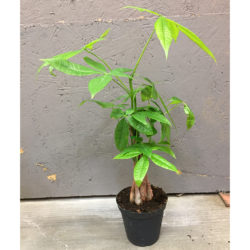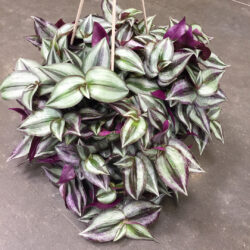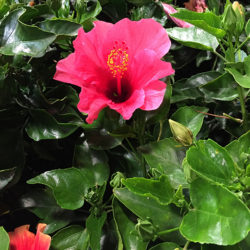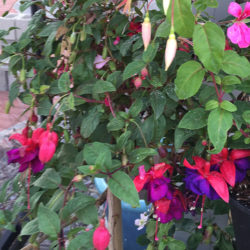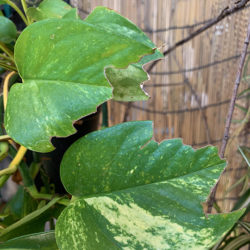Interior Design With Plants
The world of plants is much bigger than chameleons and can cause us some confusion when we just want to put together a chameleon cage! This section will review what plants we use with chameleon cages. It will also review how to use them to best effect. If you would like a simple summary then click the image.
One of the questions we chameleon people ask is what is safe for Veiled chameleons to eat. They seem to be able to safely more plants than we expect, but there is no definitive list. Therefore we rely on the community to pool our collected experiences. On this summary sheet some plant profiles have a “Veiled Tested” label. These are plants that we have had reports from the community of a Veiled Chameleon taking a bite of that plant (and surviving). This does not mean the rest are not safe. This just means that I have yet to collect a positive report of ingestion.
Plants serve functional purposes and aesthetic purposes. The aesthetic is up to your taste once you have firmly provided the functional purpose. The primary component to your cage interior will be the plants and different types of plants may be used strategically based on their shape. We will work with four types of plant shapes: Center Piece, Trailing, Wall Cover, and Accent.

Center Piece Plant

First, we will review the simplest method of plant placement. You take an appropriately sized plant and put it in the middle of your cage. The two most used plants for the centerpiece method in indoor cages are Ficus trees or Schefflera Umbrella Plants. Ficus is a genus that includes about 850 species. When you hear chameleon people talking about ficus they most always are talking about Ficus benjamina, the “Weeping Fig”, which is commonly found in home improvement stores. Schefflera is also a genus with many species. Usually we are referring to Schefflera arboricola which, like F. benjamina, is a home improvement garden center staple. Other plants can be used, such as hibiscus, but the effect is the same for these purposes.
Using a centerpiece plant is the quickest way to get foliage in your chameleon cage and has been the standard for years. Although the easiest method, the centerpiece strategy has some disadvantages.
The main disadvantage is that placing a pot on the floor creates a nice dark place for soiled water to pool and becomes an incubator for bacteria.
If you find the right centerpiece plant it can definitely work, but it is much easier and more effective for creating the chameleon environment in a cage if plants are mounted up the side of the walls. But, there is nothing wrong with the centerpiece strategy if that is what fits your vision.
Trailing Plant

These are plants that are mounted to the sides of the cage and allowed to trail downward. The most famous trailing plant is the Pothos vine. Trailing plants are a favorite tool when designing a chameleon habitat as the trailing vines can create hiding places and there are plenty of drinking surfaces. Trailing vines are best used on the sides of the cage because if you hang them from the top there will be a pot taking up a great deal of space that could be used for perching branches and creating gradients.
Wall Cover
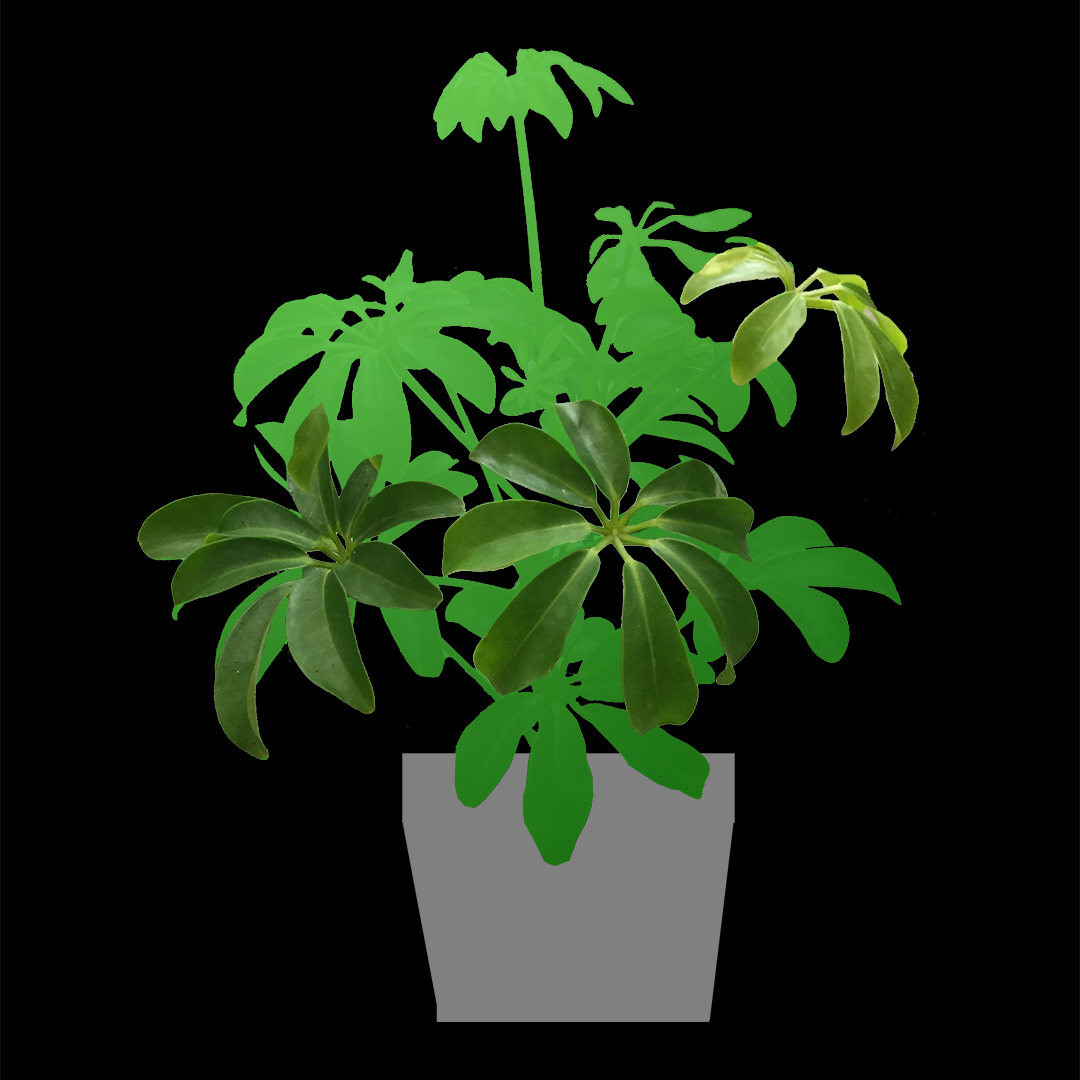
Whether for visual isolation, to help with humidity, or just for aesthetics, plants growing up along the walls helps break up the artificial cage barriers.
Any of the centerpiece plants in miniature can be placed in small pots along the inside of the cage. These can then grow up along the wall. Schefflera (Umbrella Plant) and Pachira (Money Tree) are favorites for this.
Accent Plants

These plants simply help with the ambiance. Whether it is the bright colors of a bromeliad, the attractive pattern of a polka-dot plant, or the bizarreness of a carnivorous plant, accent plants add to the overall beauty of the environment.
Accent plants are for your enjoyment. Do you like shapes? Colors? Out of the ordinary? Go ahead and put them in! Just be aware of conditions that they need and what they may grow into. For example, you may think the sensitive plant, mimosa pudica, which closes it leaves upon touch is a great addition, but a little research would show that the older plants will have thorns. So, just be aware of what you are putting in the cage. Bromiliads do well and bring a splash of color. Once again, beware of certain varieties that have sawtooth leaves. They can hide their defensive structures and you’ll have to look closely at all parts of a plant you are considering to bring in. But there are many bromiliads that will give your cage some attractive seasonal color.
A wonderful plant of note is the polka-dot plant, hypoestes phyllostachya. This is the commonly available plant with green leaves and either white, pink, or deep red polka dots all over. As a bonus for us chameleon people, this plant is originally from Madagascar.
Special Mention of Outdoor Plants
There are some plants that are usually used outdoors due to certain conditions which are not easy to replicate in the indoor vivarium. Usually this is the light level. Often they are used in rotation with more than one specimen. One will be outdoors and one in the cage. Once the one in the cage weakens it is switched out. But it is not unheard of for dedicated keepers to dial in their conditions to where plants such as Hibiscus and Mandevilla are able to grow in the indoor vivarium. The proliferations of bright LED bars has given us the light levels needed to keep more plants that are typically considered outdoor plants. It is simple, plants need light to “eat”. Some plants need more light than others. If you put more light in your cage you will be able to keep different types of plants. I have one of my terrariums with a quad T5 fluorescent fixture and two LED light bars. And this has produced a very effective plant growing environment.
Below are some typically “outdoor” plants which have been used in chameleon cages.
Special Mention of "Poisonous" Plants
We in the chameleon world are in a difficult position that we have no idea which plants are poisonous to chameleons. The poison lists we have are for mammals and birds which are just not transferable to chameleons. Although many species are reported to take a nibble here and there, it is the veiled chameleon that is our plant muncher. So we will use the Veiled Chameleon as our point chameleon in our exploration as to what plants are and are not poisonous to chameleons. Veiled Chameleons have been known to ignore the poison lists no matter how much we tell them they will die. Pothos, Ficus benjamina, and Schefflera are all considered toxic, but are regularly reduced to stems by Veiled Chameleons. But they also continue to eat plants that are considered more dangerous such as philodendron and croton. So what can we determine from this? Only that our present lists are not terribly useful. On the bright side, you can follow the present “safe plant” lists for chameleons and you will be fine. But we must not overstate the significance of those lists. We must realize that our confidence in telling people what plants are dangerous might be exaggerated. Please enjoy a mini-gallery of the remnants of poisonous plants that did not affect a Veiled Chameleon.
Would I recommend using plants that are known to be poisonous to dogs/cats/birds/etc…? Not necessarily. This section is not to encourage use or non use. It is meant to keep us humble and with a realistic understanding of what we do and do not know.

Clancy is a rescue Veiled Chameleon that is cared for by Alyssa Valentino Plumberg. He arrived in a Clancy’s Pretzels container. This picture is his second day in a proper enclosure with live plants. And how better to celebrate his new life than to sample the scenery? He is chewing on a Pothos leaf which is the most common chameleon cage plant. Pothos has decades of history of being eaten by Veiled Chameleons and, despite its inclusion on dog and cat poison lists, there have been no reports of ill health in chameleons from eating them.
Examples of Plant Functions
Plants serve functional purposes and aesthetic purposes. The aesthetic is up to your taste once you have firmly provided the functional purpose. The primary component to your cage interior will be the plants and different types of plants may be used strategically based on their shape. We will work with four types of plant shapes: Center Piece, Trailing, Wall Cover, and Accent.
Cage: Dragon Strand Large Keeper Kit

Centerpiece Plant. None used. This keeps the floor clear.
Trailing Plant. This cage uses a large pothos as a trailing plant, the function it seems to have been made for. The large and dense leaf cover creates a glen behind the wall of vines which provides a hiding place large enough for the chameleon.
Wall cover. Against the right wall notice small Schefflera arboricola Umbrella Plants. Large umbrella plants are often used as center piece plants, but smaller, or single stalk, specimens are able to be used as wall cover. In this cage some fake vines were used to cover mounting hardware and provide wall coverage from the top down. You are encouraged to use only live plants, but this is an example ofhow you would use the fake foliage.
Accent Plants. The first thing that catches people’s eyes about this cage are the brightly colored. These are accent plants included for their aesthetic appeal. They are out of the way of the chameleon and provide only basic benefit as coverage. Do not underestimate the positive effect of making your cage attractive to the non-chameleon people who will come by. Whether your spouse or a guest, sending people away with a positive impression of chameleon keeping helps the entire community. Accent plants are an easy way to do this.
Cage: Dragon Strand Large Clearside Atrium with Top Extension

Centerpiece Plant. None used.
Trailing Plant. Using a large pothos as a trailing plant and the main workhorse for chameleon needs will be a common theme. This cage was meant as a display cage, but, since it kept a living chameleon, it needed to include solid chameleon husbandry elements. The trailing plants on the left side of the cage provided the hiding areas and drinking surfaces. The chameleon that can be seen in this display cage lives at a veterinarian’s office and grew up with people milling around it. Due to the level of familiarity with humans, the copious hiding places were never used.
Wall Cover. None used
Accent Plants. This cage was specifically designed to have accent plants as a main theme. Notice to brightly colors orchids all around the cage and along the bottom there are planters full of pants with unique foliage such as the delicate Maiden’s Hair Fern, the Polka-dot plant, and prayer plant. All of these have colors or shapes that are of interest to our eyes.
Cage: Dragon Strand Medium Clearside Atrium

This cage shows how the plant elements can be used in a smaller space.
Centerpiece Plant. None used.
Trailing Plant. In a completely unexpected twist, a pothos is being used as a main cage plant to create a hiding space.
Wall Cover. Against the left wall there is a small Schefflera arboricola Umbrella Plant) and a Pachira aquatica (Chinese Money Tree). Although they have very little direct function with the chameleon, they serve to hide the left side of the cage and slow the humidity loss out the left side of the cage. )In this cage model, the sides are all solid clear except for the left side panel which is screen
Accent plants. The planter box against the back is filled with a clump of polka-dot plants which serves to break up the overwhelming visual onslaught of green.
Cage: Exo-Terra Large/ X-Tall

Centerpiece Plant. A small China Doll plant has been placed on the floor in the center to provide extra foliage. This is done because this cage will start out as a cage to hold babies and when the one baby selected to remain is chosen the centerpiece plant will be removed.
Trailing Plant. A pothos is being used as a main cage plant to create a hiding space on the right hand side of the cage.
Wall Cover. Against the left wall there is a Pachira aquatica (Chinese Money Tree). Although they have very little direct function with the chameleon, it serves to beak up the left side visual of the cage. Along the back there are two plants – a ficus pumila up top and a pothos on the bottom. At this point the plants are young and so are providing wall cover, but it will not be long before they grow and take the function of a trailing plant.
Accent plants. None yet, but the upper left side does just beg for something to be put there!
Mounting Plants on the Side vs. Centerpiece Plants
When planning your plant mounting strategy, cage size is a main consideration. There is usually limited space to work with and you must create the entire range of gradients appropriate for the size of your chameleon.
Placing a plant in the center of the cage and building around that has been a common approach, but has drawbacks. Ignoring the issues caused by the pot making cleaning difficult, the trunk disrupts the center of the cage and the leafy area is usually difficult to use as a hiding place. A plant large enough to put a big enough leafy area ends up taking up most of the cage. Plants on the bottom of the cage start to become effective with cages that have a footprint that is 48″ wide and/or 36″ deep and 60″ or more tall. This is when there is enough room for a plant that is large enough to be useful to expand and provide substantial benefit. And it is at cages of this size that mounting plants on the sides becomes more of an accent as the potted plants have enough space to expand to very useful proportions. For cages that have a footprint of less than 36″ x 36″, a centerpiece plant provides less than its full potential. Of course, using a centerpiece plants in the standard pillar shaped cages is a common practice so it obviously can be done. But, when you see those cages, check how many of them have a perching branch that truly gives a hiding place. In most cases, the centerpiece plant is actually providing the function of an oversized accent plant. There is nothing intrinsically wrong with this, but be consciously aware of what you are doing!
The advantage of using trailing plants as the main plant in the cage is that they “bubble up” with leaves right at the pot level so there is no corresponding large trunk or support structure that is required to go along with a dense leaf cover. The trialing plants then “bubble over” their pot edge. Although we must still deal with a pot of dirt, which gives us little benefit, a trailing plant is highly efficient as far as how much leaf area is produced. The one characteristic to note of the trailing plant is that it needs to be mounted up around the top of the cage to get any benefit from it. This is challenging, especially for screen cages. This is where the Dragon Strand Dragon Ledges have provided substantial benefit to the chameleon community. They allow us to take advantage of the high leaf benefit of trailing plants in our chameleon cage.
Mounting plants up the side of a chameleon cage has proven to have many advantages. By placing plants up where the chameleon can use them you can use smaller plants and increase the number of plants if you need another corner filled. Trailing vines may be used with the huge advantage that you can drape the vines anywhere that you desire to get the effect you are looking for. Using the mounted plant method gives you access to using almost any plant that is sitting in the “indoor” plant section of the store.
By putting plants up on the side of the cage you are able to keep the bottom of the cage clear. This has hygienic benefit that poop can be cleaned up quickly and you can even replace the floor with a screen floor panel to increase drainage. This removes all sitting water within the cage. And, finally, you are able to create a “floating garden” style cage which is highly effective for chameleons and looks very attractive.
Although we will mention other styles of cage interiors here, we will focus on training you on the floating garden style cage. This is the most effective method for providing the cage husbandry elements necessary for a healthy chameleon.
Where To Look For Chameleon Cage Plants
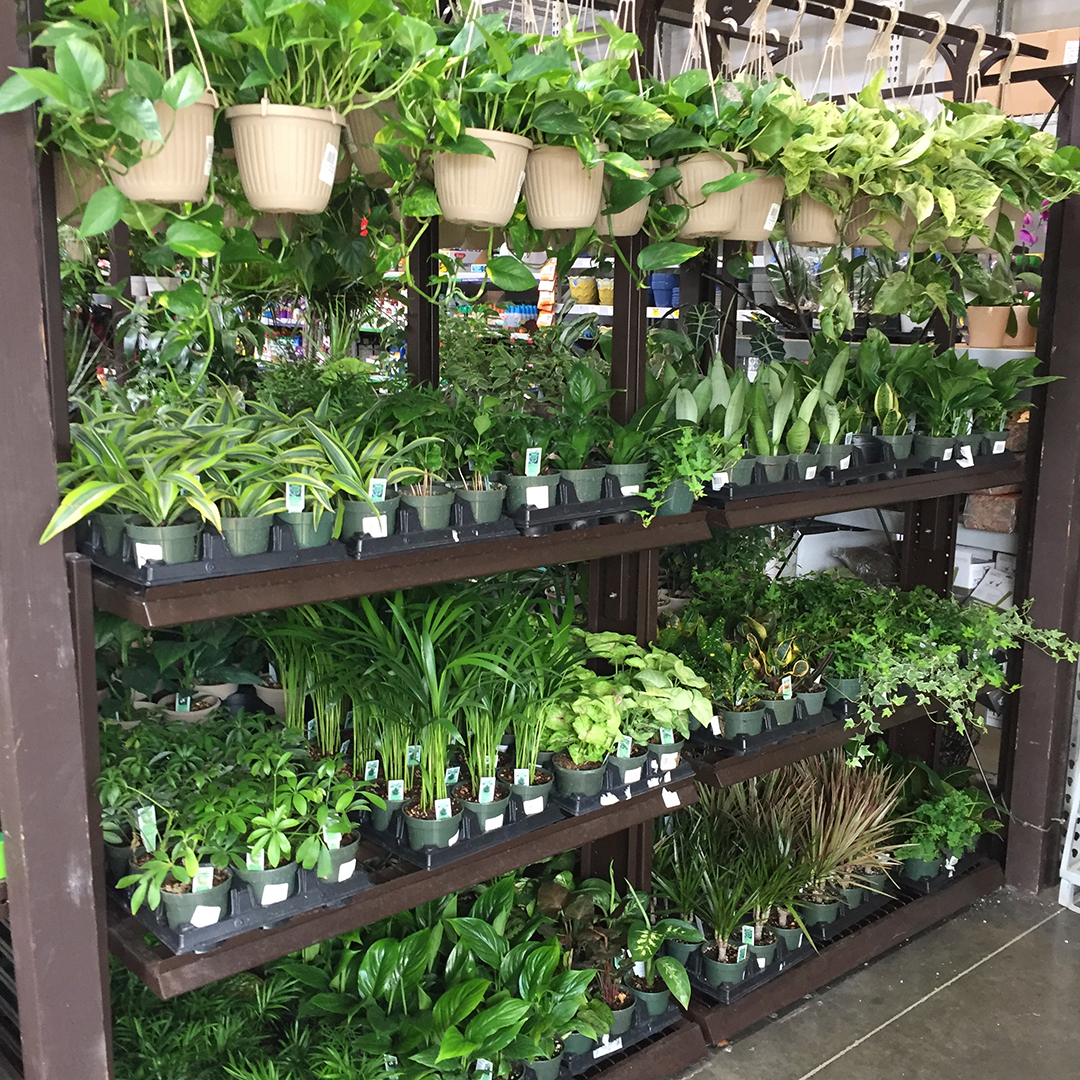
The best place to look for functional chameleon cage plants is your local home improvement store or nursery. Unless you are putting together an outdoor enclosure, you will want to shop in the house plants section. It is here where you’ll find plants that can take low light and indoor conditions. While it is true we would like to mimic wild conditions we are not to the point where we can easily create a cage that has lighting as strong as the sun indoors. So, for now, go to the house plant section.
There is a growing industry of selling plants online and you may be able to find a good source there.
How To Choose A Plant That Will Work For You
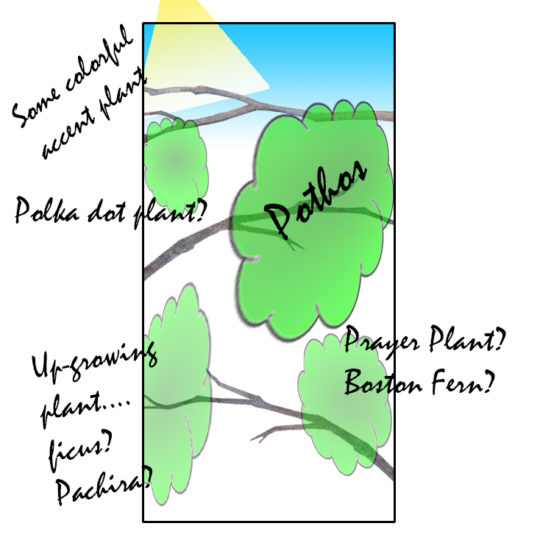
Selecting plants for your chameleon cage can be as random as finding plants you like and figuring out a place in the cage to put them to having a strict cage plan and finding a perfect fit. Having a hybrid approach is a good idea. Make a plan and then allow that plan to be further refined based on the plants you find. But once you have a strong understanding of how the plants are used you can make decisions on the fly.
A functional compromise between planning and in-the-moment artistic license is knowing that you will need one large pothos or ficus/schefflera to be your main hiding area. Once you find that one large, bushy functional plant you know the rest can be artistically chosen.
Really, the image to the right shows just about how planned out you need to be…and even that pothos can be switched on the spot if you find a suitable something else! But you have a basic idea of what shape plants you need.
Prepping The Plant For Use
Once you get your plants home you can prep them for use with whatever disinfection protocol you have decided on. They can then be re-potted if need be.
My action item list with plants brought home is to gently rinsing the leaves and soak the plant in a bucket of water. I then repot in a one gallon landscaping plastic pot to be able to slide into a mounted pot in the cage. As the plants available to me are treated with systemic pesticides, rinsing the leaves does nothing beyond remove dust. It is always a good idea for you to be aware of what pesticides, if any, are used with the plants you purchase.
Navigation
This module is part of a class on Setting Up Your Chameleon’s Cage where you learn how to build up a complete chameleon environment from start to finish. From this point you can either go back to the home room and see the other modules in this class or go on to the next module which describes how to assemble a typical commercially produced cage.
















